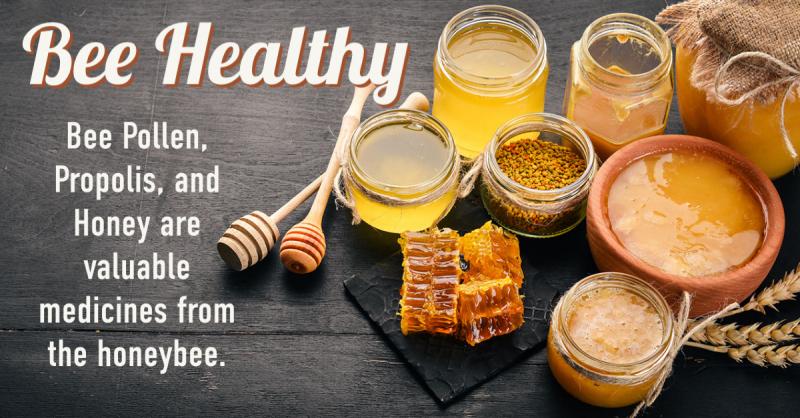
Bees are amazing creatures, and without them, many of the crops we depend on for food would not grow properly. They also produce three substances that we can use for healing—bee pollen, propolis, and honey. We’ll discuss each of these briefly in this article.
Bee Pollen
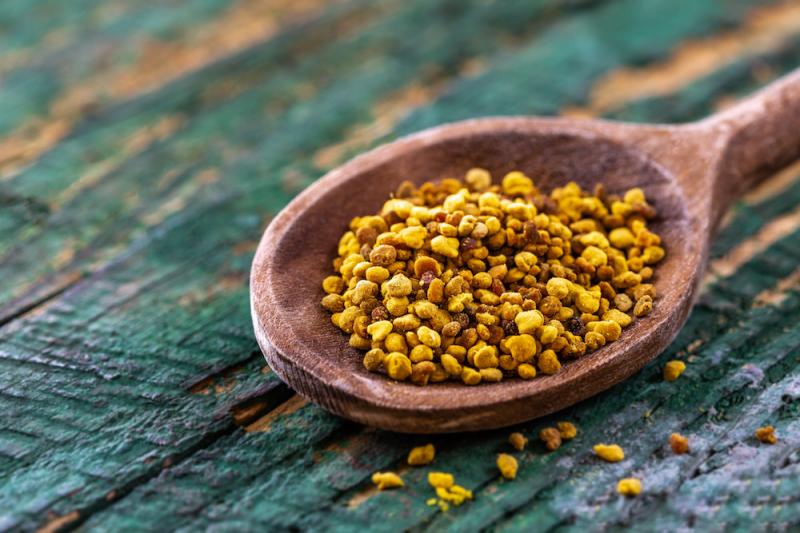 As bees fly from flower to flower collecting nectar to make honey, flower pollen collects on their legs. When this is mixed with enzyme secretions, it forms the golden granules we call bee pollen. In the hive, pollen is used to feed young bees, but it also makes a nutritious food for human beings.
As bees fly from flower to flower collecting nectar to make honey, flower pollen collects on their legs. When this is mixed with enzyme secretions, it forms the golden granules we call bee pollen. In the hive, pollen is used to feed young bees, but it also makes a nutritious food for human beings.
Bee pollen is considered a high-energy, superfood, in the West. It is a nutritive tonic in traditional Chinese medicine. There is a basis for this reputation because pollen is extremely rich in nutrients. It is high in amino acids (protein) and contains all 22 amino acids. In fact, it contains about 35-40% protein and 40-55% carbohydrates, along with fatty acids, vitamins and minerals, and other nutrients. It contains trace amounts of about 27 known minerals, numerous vitamins, thousands of enzymes, and many antioxidants. Some authors have gone so far as to claim that bee pollen contains every nutrient the human body needs.
Bee pollen is tasty, too. It has a sweet, slightly nutty flavor and tastes good sprinkled on fruit salads, cereals, or any dish where a nutty flavor would be appropriate. Some people will add bee pollen to their smoothies and green drinks for extra nutrition.
Bee Pollen as Medicine
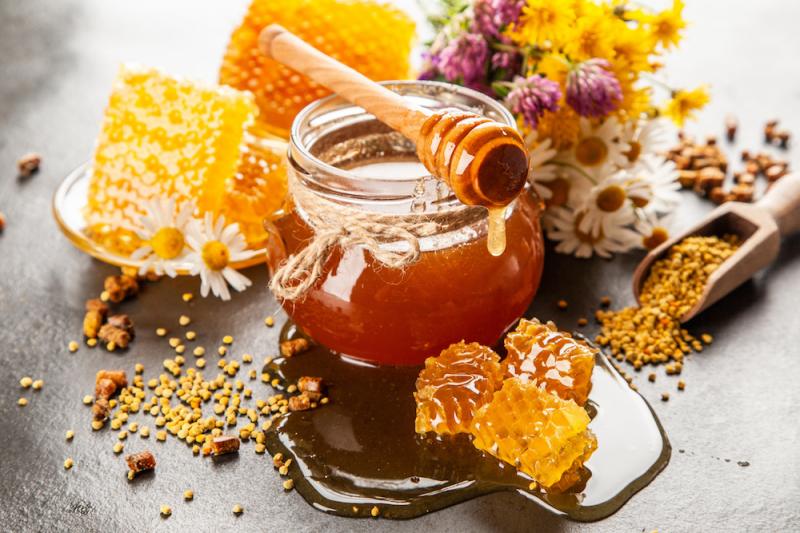 Bee pollen also has medicinal uses. It can help to balance blood sugar and reduce food cravings. It can be used as an adrenal tonic, too. But one of its best health uses is as a remedy for respiratory allergies. This may sound counter-intuitive, as pollen is a cause of respiratory allergies, but using bee pollen is a kind of homeopathic way to address these allergies.
Bee pollen also has medicinal uses. It can help to balance blood sugar and reduce food cravings. It can be used as an adrenal tonic, too. But one of its best health uses is as a remedy for respiratory allergies. This may sound counter-intuitive, as pollen is a cause of respiratory allergies, but using bee pollen is a kind of homeopathic way to address these allergies.
To use bee pollen for pollen allergies, it’s best to find pollen from local beekeepers, so it will contain the local pollen that triggers the allergies. You can also obtain raw, unfiltered honey from local beekeepers, which still contains pollen granules. If one can’t locate a source for local pollen or locally-raised unfiltered honey, nonlocal supplements can still be helpful.
To address allergies, start by taking just one or two granules of bee pollen each day. If you have no reactions, then increase the dose by another one or two granules every two or three days or a small amount of unfiltered honey. If you have a reaction reduce the dose and try again after a few days. You gradually work up to about ½ teaspoon or 2-3 capsules per day or a spoonful of the honey. This helps the body slowly adapt to the pollen and defuses the hyper-reaction of the immune system that is causing the pollen allergy.
Propolis
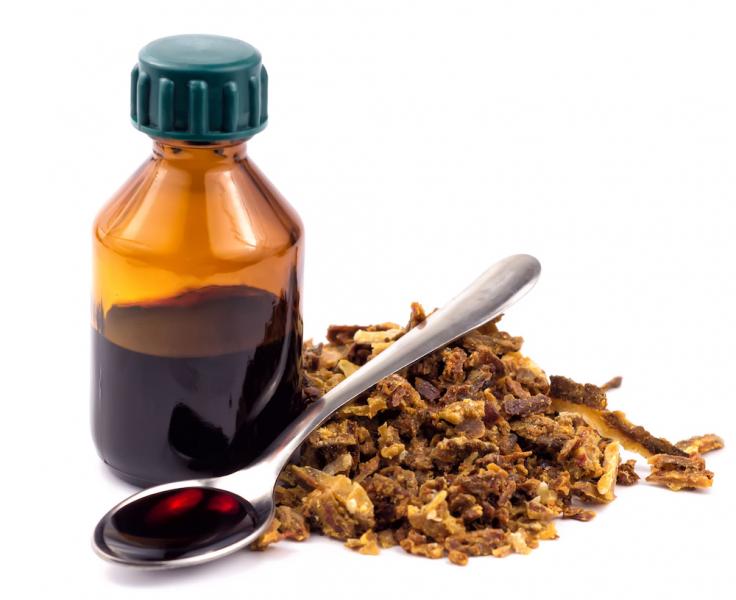 Propolis is a resinous substance that bees make from materials collected from tree buds. It’s found in small quantities in raw honey, but its benefits are destroyed when honey is heated. It’s used by bees to close small gaps in the beehive, so it can also be collected separately from the honey.
Propolis is a resinous substance that bees make from materials collected from tree buds. It’s found in small quantities in raw honey, but its benefits are destroyed when honey is heated. It’s used by bees to close small gaps in the beehive, so it can also be collected separately from the honey.
Propolis is rich in antioxidant flavonoids and has properties that make it useful for fighting infections and reducing inflammation. It is helpful against bacterial, fungal, and viral infections and is helpful both taken internally and applied topically. It’s helpful for cold sores, herpes, respiratory infections, colds, flu, and acne. It also helps wound healing, burns, and the prevention of cavities.
Honey
The most famous of all the bee products, honey, is not just a sweetener, it’s also a medicine. If you can get raw, unfiltered honey, you’ll notice a big difference in your health if you use it instead of refined sugar. My own health improved dramatically when I stopped eating refined sugar and started using honey instead. Honey is sweeter than sugar, so you can use less, and somehow, it’s more satisfying than sugar so you seem to eat less anyway.
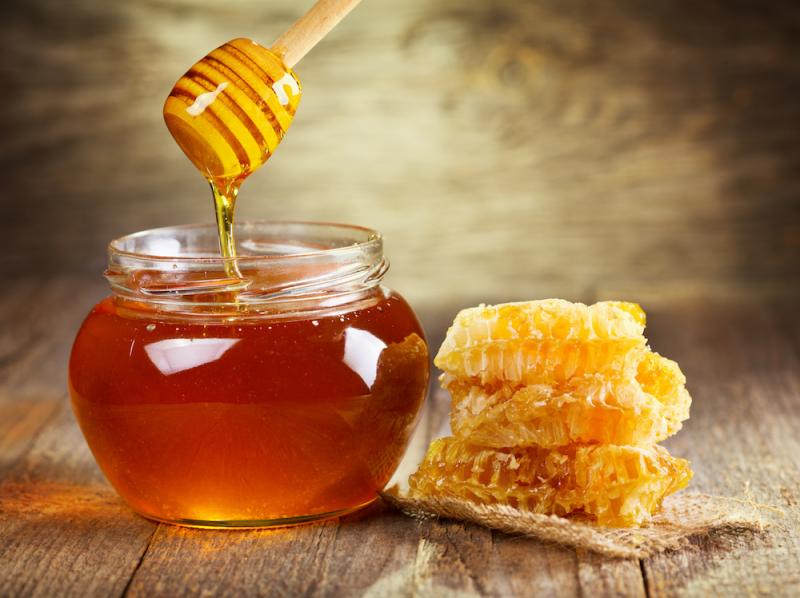 Microbes can’t grow in honey, and like wheat, it can be stored for potentially hundreds of years and still be edible, which makes it a good food to store for emergencies. But the antimicrobial nature of honey means you can also apply it topically to wounds and burns to inhibit infection and aid healing. When one of my children burned their hand grabbing a hot toaster, our midwife told us to cover the burn with honey and bandage it. Honey not only helps take the pain away, but it also keeps the burn moist and speeds healing.
Microbes can’t grow in honey, and like wheat, it can be stored for potentially hundreds of years and still be edible, which makes it a good food to store for emergencies. But the antimicrobial nature of honey means you can also apply it topically to wounds and burns to inhibit infection and aid healing. When one of my children burned their hand grabbing a hot toaster, our midwife told us to cover the burn with honey and bandage it. Honey not only helps take the pain away, but it also keeps the burn moist and speeds healing.
Honey is also useful for making herbal cough syrups. You can extract herbs that aid the lungs, such as pine bark, wild cherry, gumweed, elecampane, or eucalyptus leaf, in a mixture of half and half honey and water. Simmer the herbs in the honey and water for 20-30 minutes, strain out the herbs and to make your cough syrup.
A Word About Honeybee Collapse
With all these beneficial substances provided by bees, it’s unfortunate that bee populations are in danger. There has been a large decline in the honeybee population in America, while the exact cause of this is unknown, it’s likely that it is due to pesticides and other environmental toxins. There’s also speculation that increased electromagnetic pollution is causing problems with bees’ ability to navigate—that is to go find nectar and then return to the hive.
Whatever the cause, we should be concerned. Not only are numerous crops that are dependent on bees for pollination, but the damages to honeybee populations are also like the proverbial canary in the coal mine. They suggest that our health and well-being are probably being damaged by the same influences. Hopefully, we’ll be able to take action to protect the honeybees and the valuable contribution they make to our lives and health.
Downloads
Steven's Articles
October
-

-
Understanding Caffeine & Cellular Adaptation
Preserving the power of caffeine's buzz and the…
September
-

-
Horseradish
A pungent spice for aiding protein metabolism…
-

-
Banaba or Crepe Myrtle
A beautiful tree from Southeast Asia whose leaves…
August
-

-
Monkeyflowers
Flower essences to help see ourselves more clearly…
-

-
Mariposa Lilies
Strengthening the bond between mother and child…
-

-
The Noble Bay Leaf
A common kitchen herb for aiding digestion and…
-

-
Epimedium: Horny Goat Weed
A circulatory stimulant and kidney yang tonic…
July
-

-
The Medicinal and Nutritional Benefits of Apricots
A nutritious fruit and valuable medicinal seed for coughs
-

-
Dogwoods
Asian dogwood is used to stop excessive discharge,…
June
-

-
Neem: The Village Pharmacy
A popular Ayurvedic remedy for dental and immune…
-

-
Spilanthes: The Toothache Plant
A traditional remedy for teeth and gums, as well…
-

-
Forsythia
An anti-inflammatory, fever-reducing, and infection fighting herb
May
-

-
Buckwheat (Kashi)
A delicious, high protein, gluten-free, gut-healthy food
-

-
Leaky Gut Syndrome
Plugging the leaks on the underlying cause of…
-

-
Storksbill
An edible, medicinal, weedy herb, helpful for…

